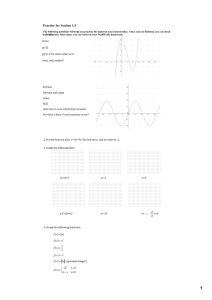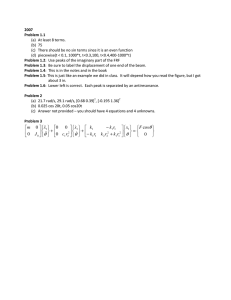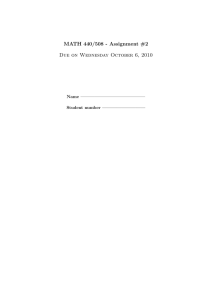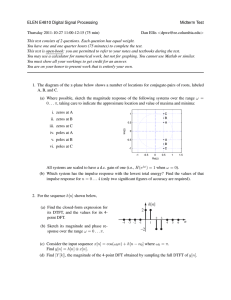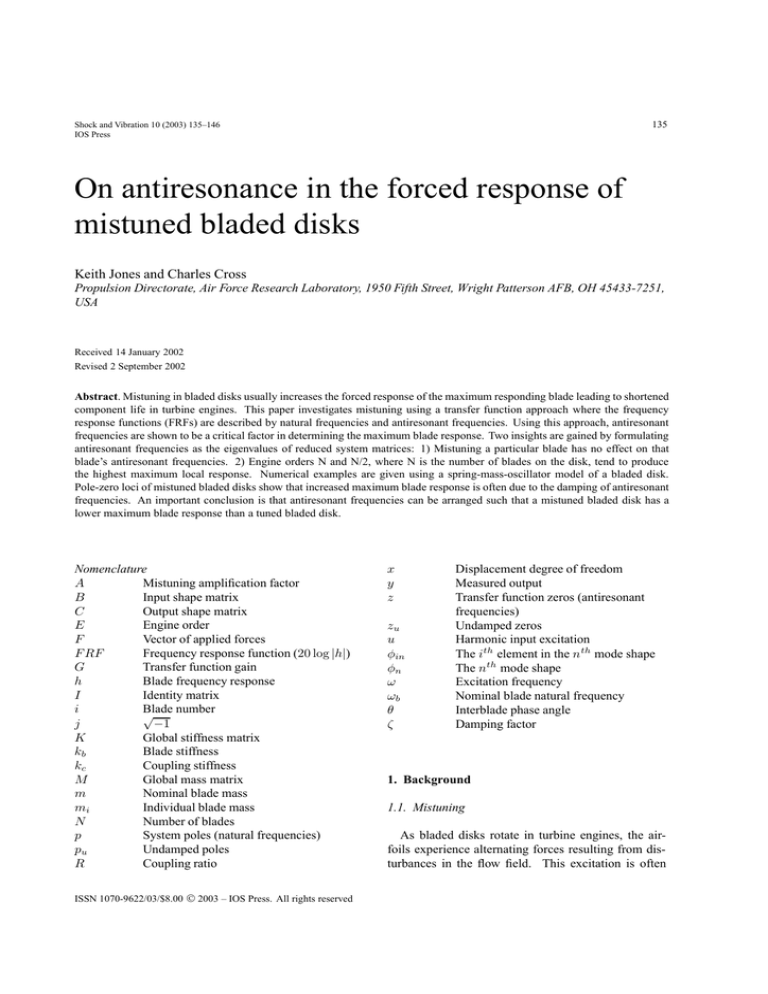
135
Shock and Vibration 10 (2003) 135–146
IOS Press
On antiresonance in the forced response of
mistuned bladed disks
Keith Jones and Charles Cross
Propulsion Directorate, Air Force Research Laboratory, 1950 Fifth Street, Wright Patterson AFB, OH 45433-7251,
USA
Received 14 January 2002
Revised 2 September 2002
Abstract. Mistuning in bladed disks usually increases the forced response of the maximum responding blade leading to shortened
component life in turbine engines. This paper investigates mistuning using a transfer function approach where the frequency
response functions (FRFs) are described by natural frequencies and antiresonant frequencies. Using this approach, antiresonant
frequencies are shown to be a critical factor in determining the maximum blade response. Two insights are gained by formulating
antiresonant frequencies as the eigenvalues of reduced system matrices: 1) Mistuning a particular blade has no effect on that
blade’s antiresonant frequencies. 2) Engine orders N and N/2, where N is the number of blades on the disk, tend to produce
the highest maximum local response. Numerical examples are given using a spring-mass-oscillator model of a bladed disk.
Pole-zero loci of mistuned bladed disks show that increased maximum blade response is often due to the damping of antiresonant
frequencies. An important conclusion is that antiresonant frequencies can be arranged such that a mistuned bladed disk has a
lower maximum blade response than a tuned bladed disk.
Nomenclature
A
Mistuning amplification factor
B
Input shape matrix
C
Output shape matrix
E
Engine order
F
Vector of applied forces
F RF
Frequency response function (20 log |h|)
G
Transfer function gain
h
Blade frequency response
I
Identity matrix
i
Blade
number
√
−1
j
K
Global stiffness matrix
Blade stiffness
kb
Coupling stiffness
kc
M
Global mass matrix
m
Nominal blade mass
Individual blade mass
mi
N
Number of blades
p
System poles (natural frequencies)
Undamped poles
pu
R
Coupling ratio
ISSN 1070-9622/03/$8.00 2003 – IOS Press. All rights reserved
x
y
z
zu
u
φin
φn
ω
ωb
θ
ζ
Displacement degree of freedom
Measured output
Transfer function zeros (antiresonant
frequencies)
Undamped zeros
Harmonic input excitation
The ith element in the nth mode shape
The nth mode shape
Excitation frequency
Nominal blade natural frequency
Interblade phase angle
Damping factor
1. Background
1.1. Mistuning
As bladed disks rotate in turbine engines, the airfoils experience alternating forces resulting from disturbances in the flow field. This excitation is often
136
K. Jones and C. Cross / On antiresonance in the forced response of mistuned bladed disks
called engine order excitation where the engine order
refers to the number of equally spaced disturbances due
to struts, vanes, or stators either upstream or downstream of the bladed disk. The resulting blade vibration causes fatigue cracks to initiate and grow. This
process is called high cycle fatigue (HCF) because of
the tremendous number of cycles accumulated at the
high rotational rates of turbine engines. (HCF can also
be present in stationary airfoils due to rotating pressure
disturbances.) The U.S. Air Force spends a significant
amount of money and effort inspecting and fixing HCF
problems.
HCF is exacerbated by mistuning, a breakdown in
the cyclic periodicity of bladed disks. A tuned bladed
disk is a perfectly cyclic symmetric structure where all
blades are identical. Unfortunately, manufacturing tolerances will inevitably cause small differences in the
geometries, material properties, or interface boundary
conditions of blades resulting in what is called a mistuned bladed disk. The maximum resonant response of
any blade on the disk, or maximum response for short,
is usually greater for mistuned bladed disk than for a
tuned bladed disk [1]. Therefore, mistuning shortens
component life, and negatively impacts the durability
and reliability of engines.
Most of the mistuning literature has relied on a modal
approach when investigating bladed disk forced response. The modal approach relates natural frequency and mode shape behavior to forced response using
concepts such as eigenvalue veering and mode localization. Examples of the modal approach include papers by Ewins [2], Wei and Pierre [3,4], and Brewer et
al. [5] After surveying the mistuning literature, Slater
et al. [6] concluded that amplified maximum response
in mistuned bladed disks is due to light damping and
mode localization.
1.2. Antiresonance
This paper investigates mistuning using a transfer
function approach where the forced response is formulated in terms of natural frequencies and antiresonant
frequencies. This approach avoids using mode shapes,
which become disordered in the presence of mistuning [3] making their effect on maximum response difficult to understand. Instead, the antiresonant frequencies incorporate the mode shape information while providing a more direct and intuitive link to maximum
forced response levels.
Antiresonance is an area of continuing research in
the structural dynamics community. Miu [7] showed
that for discrete spring-mass systems antiresonant frequencies are the resonant frequencies of some substructure. These substructures and their constraints are defined by La Civita [8] in continuous one dimensional
systems. Wahl and Schmidt [9] applied these discoveries to experimental structural analysis. Jones and Turcotte [10], D’Ambrogio and Frengolent [11], Rade et
al. [12], and Lallement and Cogan [13] have applied
antiresonance to finite element model updating with
promising results.
These papers analyzed antiresonance in single-input
single-output (SISO) transfer functions. Bladed disk
forced response requires a multi-input single-output
(MISO) method, because engine order excitation is applied at all blades. Wang’s [14] formulation of antiresonance can accommodate MISO problems and is
applied to models of bladed disks in this paper.
Although the transfer function forced response formulation is mathematically equivalent to the modal formulation, it does provide a different perspective on mistuning phenomena. The insights that come from understanding antiresonance may provide new approaches
for reducing maximum response in bladed disks.
2. Theory
2.1. Forced response formulation
The undamped equations of motion (EOM) for a
bladed disk assembly can be written as:
M ẍ + Kx = F = Bu
(1)
y = Cx
(2)
m11 m12 0 · · · m21
m21 m22 m12 0
···
M =
··· ··· ··· ··· ···
··· ··· ··· ··· ···
m12 0 · · · m21 mN N
k11 k12 0 · · · k21
k21 k22 k12 0 · · ·
K=
··· ··· ··· ··· ···
··· ··· ··· ··· ···
k12 0 · · · k21 kN N
(3)
(4)
where F is the vector of applied forces, m ii and kii
are the blade/sector mass and stiffnesses and N is the
number of blades/sectors. m ii and kii are equal for
tuned bladed disks but differ for mistuned bladed disks.
K. Jones and C. Cross / On antiresonance in the forced response of mistuned bladed disks
The EOM inputs (F ) and outputs (y) can be any linear combination of blade input forces (u) or responses (x) respectively. For the response of any particular
blade i, C is a sparse row vector with C i = 1.
The forcing function (F ) can be written as the product of an input shape matrix (B), which characterizes
the spatial properties of the applied forces, and a vector (u), which characterizes the time properties of the
forces. Engine order excitation is assumed to be harmonic excitation which differs from blade to blade by
a constant interblade phase angle (θ):
Bi = e
j(i−1)θ
i = 1, 2, . . . , N
(5)
u = ejωt
(6)
E
(7)
N
where E is the engine order.
The solution to Eq. (1) can be written as the summation of modal responses in physical coordinates (The
mode shapes are mass normalized so that φ T M φ = I):
φi1 φT1 B
φi2 φT B
+ 2 2 2 + ···
yi =
2
2
(p1 − ω ) (p2 − ω )
(8)
φiN φTN B
+ 2
u
(pN − ω 2 )
θ = 2π
where p is a system pole or natural frequency. The
frequency response, h, is defined by y = hu so that:
hi =
φi2 φT2 B
φi1 φT1 B
+
+ ···
(p21 − ω 2 ) (p22 − ω 2 )
(9)
φiN φT B
+ 2 N2
(pN − ω )
The frequency response can also be written as the
ratio of two factored polynomials in w 2 :
hi =
(10)
2
2
G(z12 − w2 )(z22 − w2 ) · · · (zN
−1 − w )
2
2
2
2
2
2
(p1 − w )(p2 − w ) · · · (pN − w )
where z is a transfer function zero and G is a constant
determined by the static deflection of the structure:
G=K
−1
(p2 )(p2 ) · · · (p2N )
B 21 22
2
(z1 )(z2 ) · · · (zN
−1 )
(11)
In this paper, Eq. (9) is referred to the modal summation approach, and Eq. (10) is referred to as the transfer function approach. The zeros of Eq. (10) are often
referred to as antiresonant frequencies in the literature,
because they cause sharp inverted resonant peaks in
the frequency response when plotted on a logarithmic
137
magnitude axis (see Fig. 1). To emphasize FRF antiresonances, this paper defines the frequency response
function (FRF) to be the magnitude of the frequency
response in decibels:
F RF = 20 log |h|
(12)
Damping was added to the transfer function FRFs
to prevent infinite resonant peaks and antiresonant valleys. Structural damping was incorporated by adding
an imaginary part to the undamped poles (p u ):
p2 = p2u + 2ζp2u j
(13)
Damping was assumed to have a similar effect on the
undamped zeros (z u ):
z 2 = zu2 + 2ζzu2 j
(14)
To validate this approach, the transfer function FRFs
were compared to the modal summation FRFs in equation (9) using the classic assumption of constant modal
damping where:
p2 = p2u + 2ζpu ωj
(15)
A ζ of 0.001 was used for this comparison as well
as the numerical examples in this paper. The transfer
function and modal summation FRFs were virtually
identical.
2.2. Calculation of transfer function zeros
Wang [14] showed that the undamped transfer function zeros (zu ) are the eigenvalues of reduced mass and
stiffness matrices:
(16)
det K̃ − zu2 M̃ = 0
where
T
M̃ = BN
M CN
(17)
T
BN
KCN
(18)
K̃ =
BN = nullspace(B)
(19)
CN = nullspace(C)
(20)
M̃ and K̃ are non-symmetric matrices whose eigenvalues (zi2 ) can be positive, negative, real or complex
numbers.
Two observations can be made about the role of zeros in bladed disk FRFs based on the above development. The first observation comes from examining the
response of an individual blade such as blade 1. The C
row vector for blade 1 is:
C = 1 0 0 ···
(21)
138
K. Jones and C. Cross / On antiresonance in the forced response of mistuned bladed disks
The nullspace of C is then:
01xN-1
CN =
IN-1xN-1
(22)
where 01xN-1 indicates a row of zeros. The choice of
blade 1 resulted in the first row of C N containing all
zeros. However, any blade i could have been chosen for
this development and would have resulted in the ith row
of CN containing all zeros. In the postmultiplication
of M and K by C N in Eqs (17) and (18), the ith row
of CN deletes the ith column from M and K. Without
the ith column, M̃ and K̃ do not contain the sector
mass and stiffness mii and kii . Since the zeros are the
eigenvalues of M̃ and K̃, they must be independent of
mii and kii . Therefore:
Conclusion 1 The zeros of a blade’s FRF are independent of any changes to its own mass and stiffness.
A second observation results from examining engine
orders N and N/2. These engine orders cause B, M̃
and K̃ to be real by Eqs (5), (17) and (18). Since the
eigenvalues of a real matrix must be real or complex
conjugates [15], all zeros are guaranteed to be real or
complex conjugates when the engine order is N or N/2.
This fact has implications on maximum response, as
explained in the next section.
2.3. Minimizing maximum response
It is well known that different mistuning patterns
can result in very different maximum response amplitudes. Under the modal summation approach,
Eq. (9), the mode shapes determine maximum response.
The modal participation factors, φ in φTn B, determine
whether the modes in the summation respond in phase
or out of phase. In phase modes reinforce each other
and increase maximum response; out of phase modes
do the opposite. But what mode shapes are desirable
for minimizing maximum response levels? This is a
difficult question, because of the disordered nature of
mistuned bladed disk mode shapes [3].
The transfer function formulation has the advantage
of providing an intuitive relationship between transfer
function zeros and maximum response. Transfer function zeros attenuate forced response just as the poles
amplify the forced response. The effect of zero spacing
on forced response can be seen in the following example where three FRFs with identical poles but different
sets of zeros are shown in Fig. 1. The poles and zeros
are listed in Table 1. The first FRF is analogous to a
tuned bladed disk FRF, where only one resonant peak
is visible [4] (The other resonances are cancelled by
the N -1 antiresonances). FRFs 2 and 3 represent blade
FRFs from two different mistuned rotors that do not
contain collocated poles and zeros.
Figure 1 shows that zero spacing is a critical factor in
determining maximum response. In FRF 1, the maximum response is determined by the full contribution of
one pole to the response without any attenuation from a
zero (The zeros are completely cancelled by collocated
poles). In FRF 2, the zeros interlace the poles, allowing
all poles to be present in the response. However, each
pole is partially attenuated by a nearby zero, so that the
maximum response is reduced below the "tuned" (FRF
1’s) maximum response. In FRF 3, two neighboring
poles are left without any interlacing or cancelling zeros between them. The result is that the contribution
from the two poles combine to increase the maximum
response above the “tuned” case, which only had one
pole present in the response. Clearly, for a given set
of poles, the spacing of zeros in the FRF determine the
maximum response and interlacing poles and zeros are
desirable for reducing maximum response below the
tuned maximum response.
The other factor that determines maximum response
is the complexity of the zeros. More complex zeros appear as increasingly “damped” antiresonances; i.e. they
provide less attenuation in the FRF, increasing maximum response. Therefore, the maximum response is
minimized when real zeros interlace the system poles.
Based on Fig. 1 and the previous discussion, the following conclusion can be given:
Conclusion 2 Mistuning maximum response amplification is caused by damping and inefficient spacing (not
interlacing the poles) of antiresonances in the blade
FRFs.
Some physical interpretation of why resonant response is reduced by a nearby antiresonance can be
gained by examining the modal FRF formulation in
Eq. (9). When the excitation frequency equals a natural frequency, the blade response is dominated by a
single system mode. However, the residual response
contribution from a neighboring mode is not negligible
for a system with sufficiently closely spaced natural
frequencies. If the residual response contribution has
opposite phase to the resonant mode’s response contribution, then the two subtract and reduce the magnitude
of the resonant response. If the excitation frequency is
moved away from one natural frequency and towards
the other, the response from one mode decreases as the
other increases. Eventually, the contributions from the
K. Jones and C. Cross / On antiresonance in the forced response of mistuned bladed disks
139
60
FRF 1 "Tuned"
FRF 2 "Mistuned"
FRF 3 "Mistuned"
50
Magnitude (db)
40
30
20
10
0
0.96
0.98
1
1.02
Frequency
1.04
1.06
1.08
Fig. 1. The effect of different zero spacings on maximum response.
Table 1
FRF Poles and Zeros for Fig. 1
Poles
1.00 + 0.001j
1.02 + 0.001j
1.04 + 0.001j
1.06 + 0.001j
Zeros for
FRF 1
“Tuned”
1.00 + 0.001j
1.02 + 0.001j
1.06 + 0.001j
two modes become equal in magnitude and opposite in
phase, creating zero response, which is an antiresonant
frequency. Therefore, antiresonant frequencies are indications that the response contributions from neighboring modes are opposite in phase and destructively
interfering with each other.
Having established the effect of antiresonance on
maximum response, we can now revisit case of engine
orders N and N/2. Recall from the last section that
these engine orders cause all antiresonances to be real or complex conjugate pairs. Neither real or complex conjugate undamped zeros are ideal for minimizing maximum response. Real zeros provide the same
attenuation in the FRF as the poles provide amplification, because the system poles are also real and use the
same damping assumption as the zeros in Eqs (13) and
(14). Ideally, it is desirable for the damped zeros in
Zeros for
FRF 2
“Mistuned”
1.01 + 0.001j
1.03 + 0.001j
1.05 + 0.001j
Zeros for
FRF3
“Mistuned”
1.00 + 0.001j
1.01 + 0.001j
1.06 + 0.001j
Eq. (14) to be less complex than the poles in Eq. (13)
so that they provide more attenuation in the FRF.
Complex conjugate zeros are also detrimental to minimizing maximum response. A pair of complex conjugate zeros will occur at the same frequency in the FRF.
These “double zeros” leave fewer zeros to attenuate
other areas of the FRF. The result is an inefficient spacing of zeros in the FRF (See Conclusion 2). Therefore,
engine orders N and N/2 will tend to produce higher
maximum response than other engine orders.
Conclusion 3 Engine orders N and N/2 tend to produce
higher maximum response than other engine orders,
because the undamped antiresonances are guaranteed
to be either real or complex conjugate pairs.
This conclusion is consistent with the findings of
Kenyon et al. [16] who showed that the maximum amplitude magnification due to mistuning is greater for
140
K. Jones and C. Cross / On antiresonance in the forced response of mistuned bladed disks
kc
kc
m
m
kb
response. With stiffness mistuning, the low frequency blade (blade 1 in Fig. 3(b)) approaches zero stiffness at higher mistuning levels. This flexible blade will
have high response across all frequencies in its FRF
(Eq. (11)), causing mistuning amplification to increase
with mistuning standard deviation. Therefore, mass
mistuning was used to focus solely on the response amplification that is caused by the breakdown of pole/zero
cancellations in Eq. (10).
kc
m
kc
kb
kb
3.2. Engine order excitation
Fig. 2. Coupled oscillator model.
engine orders N and N/2 when simple damping is assumed. Similarly, Whitehead [18] concluded that engine orders N and N/2 (where N is even in the case of
N/2) guarantees that the maximum amplitude magnification factor can be achieved.
3. Numerical examples
3.1. Bladed disk model
The coupled spring-mass oscillator model shown in
Fig. 2 was used to demonstrate the role of antiresonance in mistuning response amplification. Although
mistuning is normally applied in the literature by altering individual blade stiffnesses, in this paper mistuning was accomplished by changing the individual blade
masses. The resulting mass and stiffness matrices are
given by:
m m
mN 1
2
,
,···,
(23)
M = diag
m m
m
K = ωb2 circular
(1 + 2R, −R, 0, · · · , 0, −R)
ωb2 =
R=
kb
=1
m
kc
= 0.01
kb
(24)
(25)
(26)
where ωb , m and kb are the nominal blade natural frequency, mass and stiffness.
The reason for mistuning the blade masses can be
seen in Fig. 3(a). Here the mistuning amplification (A)
is plotted versus the standard deviation of the mistuning where mistuning amplification is defined as the ratio of maximum mistuned response to maximum tuned
A 12 bladed coupled oscillator model was used to
investigate the effect that different engine order excitations have on maximum response. Mistuning patterns
were created by randomly selecting blade frequencies
from a normal distribution with a mean of 1 and a standard deviation of 2%. The forced response of 50,000
random mistuning patterns were solved for each engine order excitation. The probability density functions (pdf) of the resulting mistuning amplifications are
shown in Fig. 4.
As predicted by Conclusion 3, engine orders 6 and 12
produced the highest average mistuning amplification,
which was approximately 50% greater than the tuned
response. Interestingly, some mistuned rotors had lower maximum response than the tuned rotor (A < 1).
This phenomena, although present in papers by Turcotte [17] and Castanier [1], has received little attention
in the literature. The cause of this mistuning attenuation is investigated in section 3.3. Another interesting note is that engine orders 1, 5, 6, and 12 seemed
incapable of producing less than the tuned maximum
response.
The role of antiresonance in determining maximum
response was demonstrated by comparing pole/zero
maps in the complex plane with magnitude FRFs. An
example of this method is shown in Fig. 5. The real axis
of the pole/zero map correlates with the FRF frequency
axis. The tuned FRF is plotted in bold to emphasize
the bandwidth of a pole (or zero with Im(z) = 0.001j)
and the tuned maximum response. Note that the system
poles always lie at 0.001 on the imaginary axis, because
of the damping assumption in Eq. (13). Zeros that
lie between the two dashed lines at ±0.001j are more
lightly damped than the poles. Therefore, they reduce
maximum response by providing more attenuation in
the FRF than the poles provide amplification.
The maximum response of a mistuned bladed disk
subjected to engine order N was examined in further
detail in Fig. 5. The pole/zero map of the maximum
K. Jones and C. Cross / On antiresonance in the forced response of mistuned bladed disks
141
Mistuning Amplification (A)
1.8
1.6
1.4
1.2
1
0
0.02
0.04
0.06
0.08
0.1
0.12
Standard Deviation
0.14
0.16
0.18
0.2
Frequency / Nominal
1.05
1
0.95
1
2
3
4
5
6
7
Blade Number
8
9
10
11
12
Fig. 3. a) Comparison of mass and stiffness mistuning (E = 2). – mass mistuning, - - - stiffness mistuning. b) Mistuning pattern.
7
E=1
E=2
E=3
E=4
E=5
E=6
E=12
6
5
pdf
4
3
2
1
0
0.8
1
1.2
1.4
Mistuning Amplification (A)
1.6
1.8
2
Fig. 4. Probability density functions of mistuning amplification for various engine orders.
responding blade FRF contains three sets of complex
conjugate zeros, symmetric about 0.001j. These three
sets of zeros create antiresonances in the FRF at the
same frequency. The middle complex conjugate zero
pair (near 1.01 on the real axis) causes a sharp antiresonance because of one lightly damped zero between
142
K. Jones and C. Cross / On antiresonance in the forced response of mistuned bladed disks
Magnitude (dB)
60
50
40
30
20
10
0.985
0.99
0.995
1
1.005
1.01
1.015
1.02
Normalized Frequency (ω/ω )
1.025
1.03
1.035
1.005
1.025
1.03
1.035
b
0.004
Imaginary
0.003
0.002
0.001
0
−0.001
−0.002
0.985
0.99
0.995
1
1.01
1.015
Real
1.02
Fig. 5. Response to Engine Order N. a) maximum Blade FRF (A = 1.56). — tuned, — mistuned. b) Pole/Zero Map. × poles, ◦ zeros. Zeros
between the dashed lines reduce the response more than the poles amplify it.
the dashed lines. All but two zeros lie on or outside of
the dashed lines, indicating that they are more damped
than tuned zeros. The complex conjugate zeros “use
up” two many zeros at the high frequency side of the
FRF, not leaving enough zeros to cover poles at the low
frequencies. Two poles are left at the low frequency
end of the FRF with no interlacing zero. As predicted
by Conclusion 2, the damping and inefficient spacing
of antiresonances increase maximum response over the
tuned FRF.
Figure 5 was found to be typical of maximum response FRFs for mistuned bladed disks in that the average zero was more complex (damped) than the poles.
This leads to a simple explanation for why mistuning
amplification increases with the number of blades [18,
4]. As the number of blades increases, each new blade
adds a resonance and antiresonance to the narrow frequency band in the FRF. Because the antiresonance is
usually more damped than the resonance, there is a new
contribution to the maximum response from this pair.
3.3. Best and worst case mistuning patterns
The largest and smallest mistuning amplifications for
engine order 3 were identified from the 50,000 solutions used to create the pdf in Fig. 4. These mistuning patterns were used to investigate the extremes of
antiresonance behavior in bladed disk FRFs. Engine
order 3 was chosen because it produced the greatest
reduction in maximum response from the tuned bladed
disk.
Figure 6 shows the FRF and pole/zero map of the
maximum responding blade in the worst case mistuning pattern. The peak responding blade has no lightly damped antiresonances appearing in the FRF. The
pole/zero map shows that the antiresonances are more
complex (damped) than the poles. Finally, there are
two poles with no interlacing zeros in the highest response region of the FRF. The result is an 84% increase
in maximum response over a tuned bladed disk.
Figure 7 shows the FRF of the best case mistuning
pattern. In this case, even the peak responding blade
FRF has three very lightly damped antiresonances in the
response. Furthermore, the antiresonances are spread
evenly across the FRF so that they either interlace or
very nearly cancel the poles. These two factors combined to produce a 18% reduction over tuned response
and a 34% reduction over the mean mistuned maximum
response from the distribution in Fig. 4. If this mistuning state could be maintained in a turbine engine, it
would significantly extend bladed disk life.
3.4. Antiresonance sensitivity to mistuning
Wei and Pierre [3] showed that bladed disk eigenvalues (p2u ) and eigenvectors (φ) are very sensitive to
K. Jones and C. Cross / On antiresonance in the forced response of mistuned bladed disks
143
Magnitude (dB)
60
50
40
30
20
0.99
1
0.99
1
1.01
1.02
Normalized Frequency (ω/ωb)
1.03
1.04
1.03
1.04
Imaginary
0.004
0.002
0
0.002
0.004
1.01
Real
1.02
Fig. 6. Largest Amplification Mistuning Pattern (A=1.84, E=3). a) Maximum Blade FRF. — tuned, — mistuned. b) Pole/Zero Map. × poles,
◦ zeros. Zeros between the dashed lines reduce the response more than the poles amplify it.
Magnitude (dB)
50
40
30
20
10
0.99
0.995
1
1.005
1.01
1.015
1.02
Normalized Frequency (ω/ω )
1.025
1.03
1.035
1.025
1.03
1.035
b
Imaginary
0.003
0.002
0.001
0
−0.001
0.99
0.995
1
1.005
1.01
1.015
Real
1.02
Fig. 7. Smallest Amplification Mistuning Pattern (A=0.82, E=3). a) Maximum Blade FRF. — tuned, — mistuned. b) Pole/Zero Map. × poles,
◦ zeros. Zeros between the dashed lines reduce the response more than the poles amplify it.
the amount of mistuning. The closely spaced eigenvalues of the tuned system “veer” away from each other
as the amount of mistuning is increased. The tuned
eigenvectors change from having extended participation in many blades to being more localized around one
or a few blades when mistuning is increased. Since
144
K. Jones and C. Cross / On antiresonance in the forced response of mistuned bladed disks
0.005
0.004
0.003
Imaginary
0.002
0.001
0
−0.001
−0.002
−0.003
0.9
0.92
0.94
0.96
0.98
1
1.02
1.04
1.06
1.08
1.1
Real
Fig. 8. Blade 8 pole/zero locus as mistuning standard deviation is varied from 0 to 0.1 for the mistuning pattern given in Fig. 3(b). × poles,
◦ zeros.
bladed disk antiresonances are defined by the system
eigenvalues and eigenvectors (i.e. they are the zeros of
Eq. (9)), they show a similar sensitivity to the amount
of mistuning.
Consider the mass mistuning example from Fig. 3.
Since there is a different set of antiresonances for each
blade’s FRF, a representative blade must be chosen for
examination. Blade 8 was chosen because it was the
maximum responding blade between a standard deviation of 0.01 and 0.1 in Fig. 3a. Blade 8’s pole/zero locus
as mistuning standard deviation is increased is shown
in Fig. 8. Figure 8 shows that the zeros spread along
the real axis along with the veering poles. The complexity of the zeros varies wildly with small mistuning, with more zeros increasing their complexity than
decreasing. As the mistuning gets larger, all but two
antiresonances are returning to the same complexity as
the poles. The temporary increase in zero complexity
corresponds with the high mistuning amplification seen
between 0.01 and 0.05 in Fig. 3a. This supports the
conclusion that mistuning amplification is related to the
damping (increased complexity) of the antiresonances.
Lastly, to validate Conclusion 1, the sensitivity of a
blade’s antiresonances to changes to its own mass was
investigated. Figure 9 shows the effect on a blade’s
FRF when mistuning is applied to that blade only. The
natural frequency of the blade whose FRF is shown
in Fig. 7 was increased by 1% of the nominal blade
frequency (ω b ). This blade’s FRF and pole/zero map
are shown before and after the self-mistuning in Fig. 9.
As predicted by Conclusion 1, the zeros are insensitive
to the mistuning. However, the FRF changes due to the
movement of the poles. As a further note, the blade is no
longer the peak responding blade after self-mistuning.
4. Conclusions
This paper applied antiresonance theory to the forced
response of bladed disks to engine order excitation.
Bladed disk frequency response was formulated using
a transfer function approach. Using this method, the
response can be written completely in terms of eigenvalues and antiresonances without using mode shapes.
Since antiresonances create attenuation in the FRF,
their effect on maximum response can be easily understood.
The transfer function formulation led to the following conclusions:
– The zeros of a blade’s FRF are independent of any
changes to its own mass and stiffness.
– Mistuning maximum response amplification is
caused by damping and inefficient spacing of antiresonances in the blade FRFs.
K. Jones and C. Cross / On antiresonance in the forced response of mistuned bladed disks
145
Displacement (dB)
50
40
30
20
10
0.99
0.995
1
1.005
0.995
1
1.005
1.01
1.015
1.02
Normalized Frequency (ω/ωb)
1.025
1.03
1.035
1.025
1.03
1.035
Imaginary
0.003
0.002
0.001
0
−0.001
0.99
1.01
1.015
Real
1.02
Fig. 9. Blade FRF Sensitivity to Self Mistuning (E=3). a) Blade FRF. — Before, - - - After. b) Pole/Zero Map. (×,◦) - (pole, zero) before,
(,♦) - (pole, zero) after. Zeros between the dashed lines reduce the response more than the poles amplify it.
– Engine orders N and N/2 tend to produce higher
maximum response levels than other engine orders, because the undamped antiresonances are
guaranteed to be either real or complex conjugate
pairs.
– Mistuning amplification increases with the number
of blades, because the antiresonances are usually
more damped than the closely spaced resonances.
– Mistuned bladed disks can have lower maximum
response than tuned bladed disks. This mistuning
attenuation is caused by lightly damped antiresonances that are spread throughout all blade FRFs.
Robust minimum maximum response mistuning designs for bladed disks would be an attractive weapon
against high cycle fatigue. Since antiresonance sensitivities can be easily calculated [14], structural optimization routines may be able to find such mistuning
patterns using the reduction of the imaginary part of the
antiresonances as a goal. This is a recommended area
for further research.
References
[1]
M.P. Castanier and C. Pierre, Consideration of the Benefits
of Intentional Mistuning for the Forced Response of Turbomachinery Rotors, Proceedings of the 1997 International Mechanical Engineering Congress and Exposition, Dallas, TX,
USA, 1997.
[2]
D.J. Ewins, The Effects of Detuning Upon the Forced Vibrations of Bladed Disks, Journal of Sound and Vibration 9(1)
(1969), 65–79.
[3] S. Wei and C. Pierre, Localization Phenomena in Mistuned Assemblies with Cyclic Symmetry Part I: Free Vibrations, Journal of Vibration, Acoustics, Stress, and Reliability in Design
110 (Oct 1988), 429–438.
[4] S. Wei and C. Pierre, Localization Phenomena in Mistuned
Assemblies with Cyclic Symmetry Part II: Forced Vibrations,
Journal of Vibration, Acoustics, Stress, and Reliability in Design 110 (Oct 1988), 439–449.
[5] M.E. Brewer, M.P. Castanier and C. Pierre, Effects of Harmonic Intentional Mistuning on the Free Response of Bladed
Disks, Proceedings of the 1999 ASME Design Engineering
Technical Conferences, Las Vegas, Nevada, USA, Sep 1999.
[6] J.C. Slater, G.R. Minkiewicz and A.J. Blair, Forced Response
of Bladed Disk Assemblies – A Survey, The Shock and Vibration Digest: Center for Intelligent Materials Systems and
Structures 31(1) (Jan 1999), 17–24.
[7] D.K. Miu, Physical Interpretation of Transfer Function Zeros
for Simple Control Systems with Mechanical Flexibilities,
Journal of Dynamic Systems, Measurement, and Control 113
(Sep 1991), 419–424.
[8] M. La Civita and A. Sestieri, On Antiresonance Interpretation and Energy Concentration Along Continuous OneDimensional Systems, Proceedings of the 15th International
Modal Analysis Conference, 1997, pp. 778–784.
[9] F. Wahl and L. Forrai, On the Significance of Antiresonance
Frequencies in Experimental Structural Analysis, Journal of
Sound and Vibration 219(3) (1999), 379–394.
[10] K. Jones and J. Turcotte, Finite Element Model Updating Using Antiresonant Frequencies, Journal of Sound and Vibration
252(4) (May 2002), 717–727.
146
[11]
[12]
[13]
[14]
[15]
K. Jones and C. Cross / On antiresonance in the forced response of mistuned bladed disks
W. D’Ambrogio and A. Fregolent, The Use of Antiresonances
for Robust Model Updating,” Journal of Sound and Vibration
236 (Sep 2000), 227–243
D.A. Rade, G. Lallement and L.A. da Silva, A Strategy for
the Enrichment of Experimental Data as Applied to an Inverse Eigensensitivity-Based F.E. Model Updating Method,
Proceedings of the 14th International Modal Analysis Conference, 1996, pp. 1078–1085.
G. Lallement and S. Cogan, Reconciliation Between Measured and Calculated Dynamic Behaviors : Enlargement of
the Knowledge Space, Proceedings of the 10th International
Modal Analysis Conference, 1992, pp. 487–493.
B.P. Wang, Antiresonance and its Sensitivity Analysis in Structural Systems, AIAA Paper 98-1751, 1998, pp. 431–440.
D.G. Zill and M.R. Cullen, Advanced Engineering Mathemat-
ics, PWS-Kent Publishing, Boston, 1992, pp. 435.
J.A. Kenyon, J.H. Griffin and D.M. Feiner, Maximum Bladed
Disk Forced Response from Distortion of a Structural Mode,
ASME Paper GT-2002-30426 International Gas Turbine Institute ASME Turbo Expo 2002, Amsterdam, the Netherlands,
2002.
[17] J.S. Turcotte, A Coupled Plate Model of a Bladed Disk Assembly, Proceedings of the 35th AIAA/ASME/SAE/ASEE Joint
Propulsion Conference, Los Angeles, California, USA, Jun
1999.
[18] D.S. Whitehead, The Maximum Factor by Which Forced Vibration of Blades Can Increase Due to Mistuning, Journal
of Engineering for Gas Turbines and Power 120 (Jan 1998),
115–119.
[16]
International Journal of
Rotating
Machinery
Engineering
Journal of
Hindawi Publishing Corporation
http://www.hindawi.com
Volume 2014
The Scientific
World Journal
Hindawi Publishing Corporation
http://www.hindawi.com
Volume 2014
International Journal of
Distributed
Sensor Networks
Journal of
Sensors
Hindawi Publishing Corporation
http://www.hindawi.com
Volume 2014
Hindawi Publishing Corporation
http://www.hindawi.com
Volume 2014
Hindawi Publishing Corporation
http://www.hindawi.com
Volume 2014
Journal of
Control Science
and Engineering
Advances in
Civil Engineering
Hindawi Publishing Corporation
http://www.hindawi.com
Hindawi Publishing Corporation
http://www.hindawi.com
Volume 2014
Volume 2014
Submit your manuscripts at
http://www.hindawi.com
Journal of
Journal of
Electrical and Computer
Engineering
Robotics
Hindawi Publishing Corporation
http://www.hindawi.com
Hindawi Publishing Corporation
http://www.hindawi.com
Volume 2014
Volume 2014
VLSI Design
Advances in
OptoElectronics
International Journal of
Navigation and
Observation
Hindawi Publishing Corporation
http://www.hindawi.com
Volume 2014
Hindawi Publishing Corporation
http://www.hindawi.com
Hindawi Publishing Corporation
http://www.hindawi.com
Chemical Engineering
Hindawi Publishing Corporation
http://www.hindawi.com
Volume 2014
Volume 2014
Active and Passive
Electronic Components
Antennas and
Propagation
Hindawi Publishing Corporation
http://www.hindawi.com
Aerospace
Engineering
Hindawi Publishing Corporation
http://www.hindawi.com
Volume 2014
Hindawi Publishing Corporation
http://www.hindawi.com
Volume 2010
Volume 2014
International Journal of
International Journal of
International Journal of
Modelling &
Simulation
in Engineering
Volume 2014
Hindawi Publishing Corporation
http://www.hindawi.com
Volume 2014
Shock and Vibration
Hindawi Publishing Corporation
http://www.hindawi.com
Volume 2014
Advances in
Acoustics and Vibration
Hindawi Publishing Corporation
http://www.hindawi.com
Volume 2014

